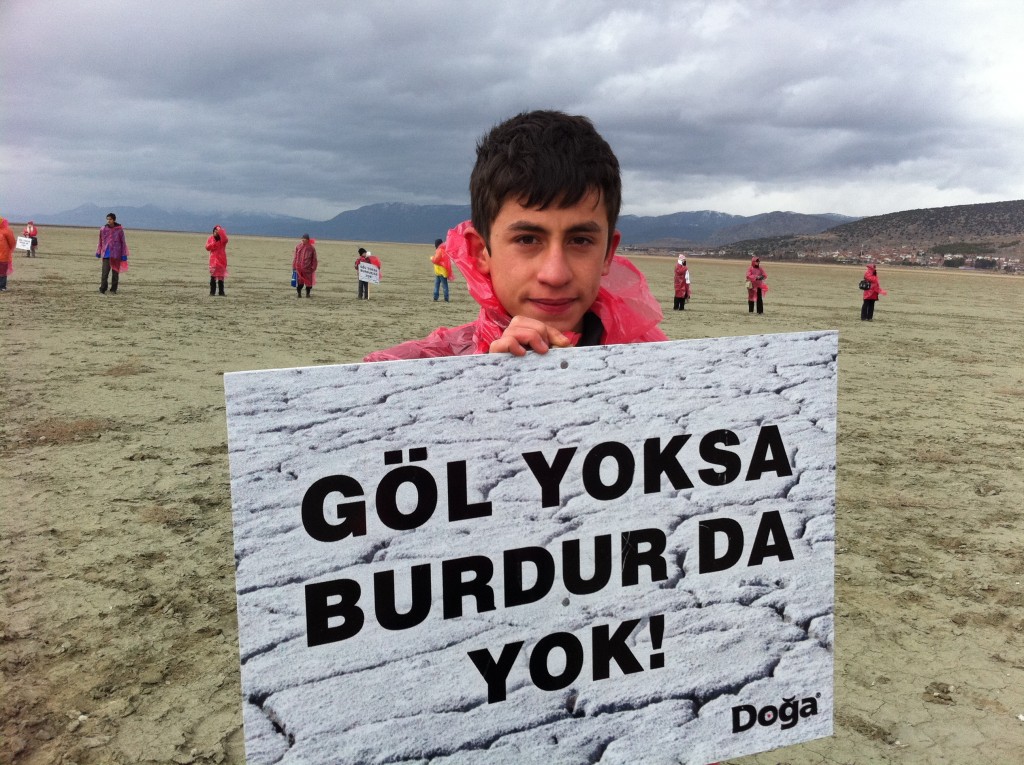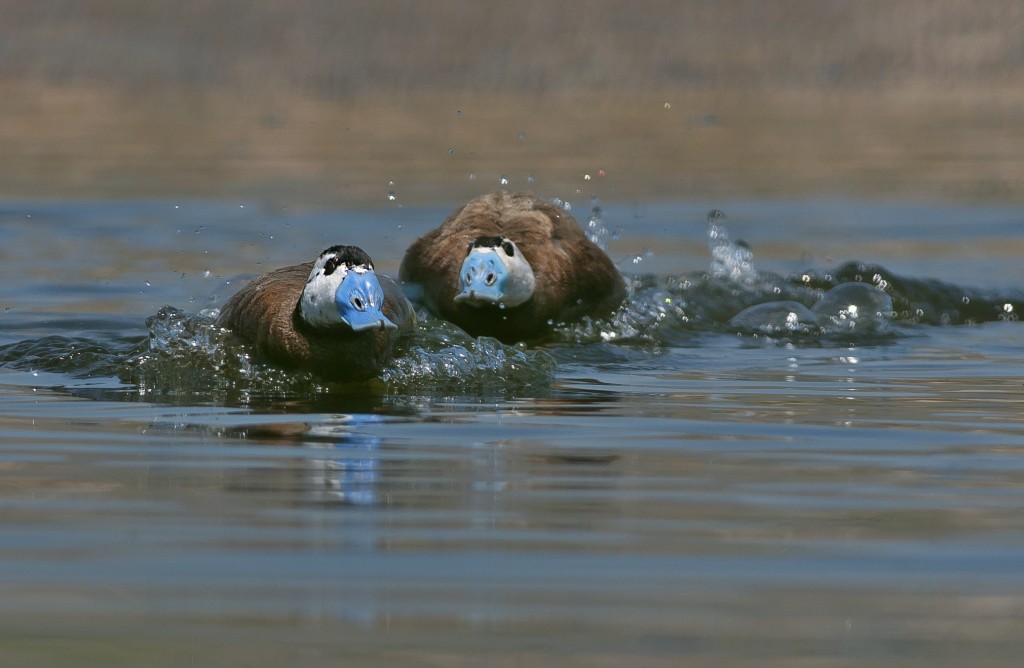-

If Burdur Lake dries up, the climate in the basin will change. Humidity will decrease, rainfall will be irregular, temperatures at night will drop, and frost will become more frequent. (Sign: No lake, no Burdur!)
Lake Burdur is designated as a wetland of international importance under the Ramsar Convention. Located within the provinces of Burdur and Isparta in southwestern Turkey, Lake Burdur is the most important wintering site in the world for the globally threatened white-headed duck (Oxyura leucocephala) whose numbers have decreased to less than 1,000 individuals in Burdur over the past years. The site is also home to other waterfowl species in winter, as well as the Burdur killifish (Aphanius sureyanus) that is endemic to the lakes region.Burdur Lake has lost approximately one third of its water since 1975 because of upstream dams and reservoirs constructed on the rivers that feed the lake. On Bozcay alone (the main river that feeds the lake) there are 14 dams and reservoirs that hold most of the rainfall in winter and spring, preventing the water from reaching the lake. In fact, Bozcay no longer feeds Burdur Lake. Since the construction of these dams, the lake’s water level has decreased by over 12 meters and its surface area has shrunk to 153 km2, which is 75km2 less than its original size. Although the basin has been witnessing a period of high precipitation since 1995, water levels continue to decrease.
A large number of wells drilled around the lake aggravate the problem by decreasing the level of underground water. The amount of water extracted from licensed wells alone is estimated to be 42hm3 (43 billion liters). The situation is made worse by agricultural irrigation practices causing unnecessary wastage because water-saving irrigation methods are not widespread.
If Burdur Lake dries up, the climate in the basin will change. Humidity will decrease, rainfall will be irregular, temperatures at night will drop, and frost will become more frequent. The effects of a continental climate will be felt more harshly, resulting in negative consequences on agriculture and animal breeding. Under these conditions, more water will be needed to irrigate the same amount of land. This will increase irrigation costs related to agriculture and animal breeding. The rise in the production costs of crops including fodder crops will again adversely affect agriculture and animal breeding.
The environmental impact of the shrinking of Burdur Lake is already being felt. It has already led to the disappearance of the shallow coasts, which are vital for many water birds including the white-headed duck. Since the lake is shrinking, the habitats of water birds and the Burdur killifish are disappearing. Immediate action is required to implement solutions to prevent any further shrinking of the lake.

Lake Burdur is the most important wintering site in the world for the globally threatened white-headed duck (Oxyura leucocephala) whose numbers have decreased to less than 1,000 individuals in Burdur over the past years.
Solutions
The agricultural lands around Burdur Lake are irrigated through the dams built on the rivers that feed the lake. The dams were not properly planned and are preventing the rivers from reaching the lake, causing it to shrink. In addition, the water sent to surrounding agricultural lands is wasted through wild irrigation methods. If methods such as drip and sprinkler irrigation are used in all of the Burdur Lake Basin, the amount of water saved would amount to 62,6 hm3. This is 1.5 times more than the amount of water lost by Burdur Lake every year. If this amount of water is allowed to reach Burdur Lake, the water level is very likely to start to increase.In 2007, Doğa initiated a conservation project in the region with local stakeholders and the support of the MAVA Foundation. In order to prevent the loss of the lake, Doğa has been engaged in extensive work to promote saving water in agriculture, strengthen the ties of the locals to the lake and support the implementation of Lake Burdur Management Plan (2008-2012). Efforts are currently focused on the revision of the Lake Burdur Management to extend to the whole basin and thoroughly address the water flow and over-extraction problems. Through our Burdur office, we have carried out several activities in cooperation with the Burdur Municipality as well as relevant public institutions and civil society groups in Burdur. Our achievements include:
– Reaching and informing 1,524 farmers in 41 villages and three towns about the advantages of drip irrigation for saving energy and water.
– Three drip irrigation pilot sites were established in two different villages and one in the city center in Burdur through the purchase and delivery of drip irrigation systems to pilot farmers.
– Doğa contributed to the preparation and implementation of the Burdur Lake Management Plan (2008-2012).
– Training programmes are carried out in schools on species living in and around Burdur Lake. Birdwatching trips for youth are organized.
– Awareness-raising activities include a documentary film entitled ‘The Story of Water: Burdur Lake’, which won the best documentary film of the year award in 9. International Environment Short Film Festival.Doğa will continue its efforts to prevent the drying up of Burdur Lake and take action, in cooperation with other organizations, to achieve the following:
– Remind all the people living in the area that the lake is essential for the continuation of life in Burdur,
– Promote rain-fed agriculture methods in the basin,
– Widen the scope of the Burdur Lake manage Plan to include all activities affecting the lake in the basin, enabling more surface and underground water reaching the lake.Photograph: © Özcan Yüksek, Ali Şenel
